Plastics – flying high
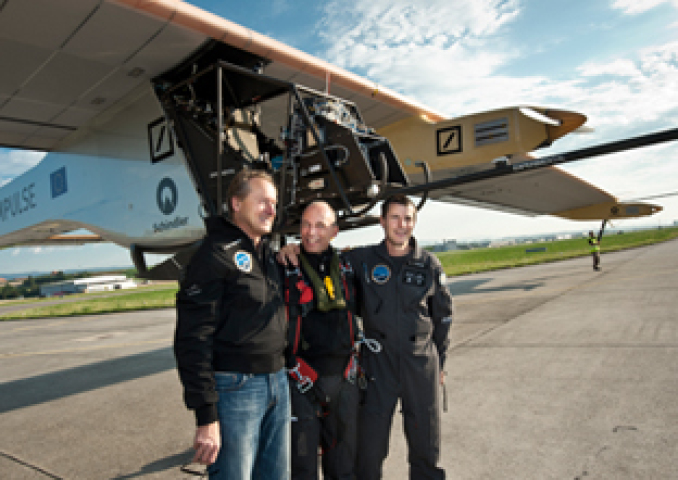
The Solar Impulse wrote aviation history on 08 July 2010 when it made an uninterrupted flight of over 24 hours powered only by solar panels and lithium batteries.
Its 64-metre wingspan is the same as that of an Airbus A340. Yet, it weighs no more than a compact car.
André Borschberg: What physical preparation do you do to fly the single-seater HB-SIA ?
I prepare myself not just physically but, also mentally.
I do muscle training for that vital physical fitness, and yoga and meditation to help me get mentally ready.
26 hours spent immobile in a six-foot cabin can be a long time, so I use some breathing techniques to help, and I’ve also learned to work my muscles without moving.
It’s uncomfortable for the first three hours, you feel a bit stiff, but these little physical exercises get rid of it all!
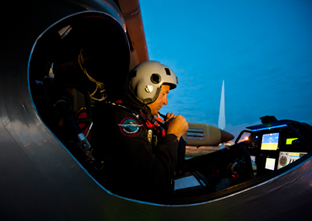
André Borschberg: What exactly do composite materials and polymers do in the Solar Impulse ?
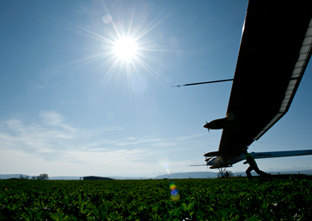 Solar Impulse is currently four times lighter than a conventional glider and half as dense as a feather: making the aircraft ever lighter is a big aim of the project because, as we can’t have a heavy duty power source, the plane needs to be as light as possible.
Solar Impulse is currently four times lighter than a conventional glider and half as dense as a feather: making the aircraft ever lighter is a big aim of the project because, as we can’t have a heavy duty power source, the plane needs to be as light as possible.
Most of that is down to the composites and polymers used pretty nearly throughout the plane: from the fuselage, made of carbon fibre tubes and open-cell foamed plastic, through the insulating-foam cockpit shell to the 12,000 photovoltaic cells encapsulated in 17 micron ultrathin film and the cold-insulated lithium polymer batteries.
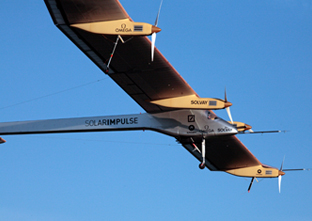 Chemicals and plastics are vital to address the project’s big challenges: the energy chain and aircraft lightness. That's why we are working with selected partners like Solvay and Bayer.
Chemicals and plastics are vital to address the project’s big challenges: the energy chain and aircraft lightness. That's why we are working with selected partners like Solvay and Bayer.
Solvay is currently fitting on-board the first generation prototype HB-SIA, 11 different materials for a score of applications and a total of 6000 pieces. And Bayer polyurethane foams are being used in the cockpit insulation, engine cowling and wings.
This aircraft is being built using the most cutting-edge technologies,
but always with a view to pushing them further, whether in the field of composite structures, so-called smart lightweight materials and energy production, and storage methods.
Bertrand Piccard: How does the collaboration with Solvay and Bayer work ? Do you ask them to develop a particular material or do they propose developing a particular solution specifically for Solar Impulse ?
Our partners – both Solvay which was a part of our adventure from the outset, and Bayer which has since joined us - have boosted their research to give their products improved performances and work on innovative ideas to optimise energy management and maximise material lightness.
Solvay has not invented new products, but improved existing ones, e.g., boosting the efficiency of the lithium polymer batteries by 40% from 180 Watt-hours/Kg in 2007 to 240 today. We’re hoping to get up to 260/280 Watt-hours/Kg battery for the next plane.
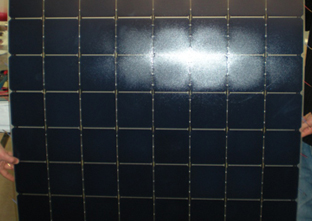
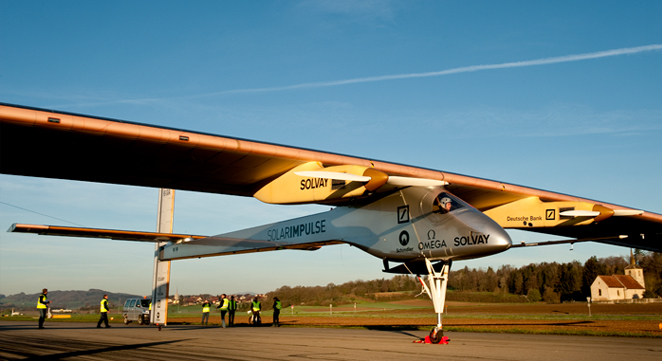 We aren’t developers of technology, but of a new concept. The idea is to integrate the technologies that are available today to show that by using them, we can cut our energy consumption and so reduce our dependence on oil as a fuel. It was only by comparing requirements and exploring the potential of each that unique aviation solutions emerged.
We aren’t developers of technology, but of a new concept. The idea is to integrate the technologies that are available today to show that by using them, we can cut our energy consumption and so reduce our dependence on oil as a fuel. It was only by comparing requirements and exploring the potential of each that unique aviation solutions emerged.
Solar Impulse has been a magnet for people who stepped up to the plate when asked to do the impossible. We managed to get them interested in the project while the plane was still on the drawing board.
Andre Borschberg: On which parts of the plane will the development of ultra-lightweight materials let the HB-SIA go even further ?
 For a start, it won’t be the HB-SIA, but a second plane, the HB-SIB which, in 2013, will hopefully be doing an Atlantic crossing, before attempting a 5-leg round-the-world flight in 2014.
For a start, it won’t be the HB-SIA, but a second plane, the HB-SIB which, in 2013, will hopefully be doing an Atlantic crossing, before attempting a 5-leg round-the-world flight in 2014.
Its overall shape and appearance will look like the first prototype. But we still want to make it 10% lighter overall for a slightly bigger span: that means having a weight gain, mainly in the photovoltaic cells and the batteries which are still pretty heavy, so that means drastically reducing the weight of the rest of the aircraft to optimise the entire energy chain and maximise aerodynamic efficiency.
With an energy density of 240 Watt-h/Kg, the weight of batteries needed for an overnight flight amounts to 400 kg, or ¼ of total aircraft weight. An improved battery capacity would let us have a second pilot.
To generate more energy for longer flying times we need to increase the number of photovoltaic cells, which means lengthening the wings they are mounted on.
The plane will be made of epoxy resin-impregnated carbon fibre honeycomb or foam core sandwich structures.
Bayer researchers will be improving the material’s stability by strengthening the epoxy resin with carbon nanotubes which will further enhance the material’s mechanical properties and reduce aircraft weight.
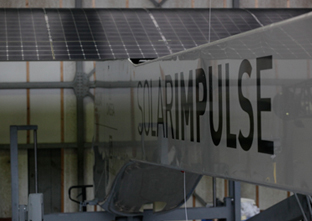
 The nanotube-reinforced material will also reduce the thermal expansion experienced by composite materials and prevent them from cracking when going from a temperature of -50° at 12,000 m to 30° at 1,500 m.
The nanotube-reinforced material will also reduce the thermal expansion experienced by composite materials and prevent them from cracking when going from a temperature of -50° at 12,000 m to 30° at 1,500 m.
Using small plastic parts rather than metal ones for all the nuts, bolts and housings also gives a big weight gain. We’re running a daily weight-loss programme!
Torlon® (Solvay’s special nylon) for example used in many mechanical parts is three times lighter than metal.
Bertrand Piccard: Which are you most proud of: the environmental or technological achievement ?
 The main thing for us is to change attitudes. Aviation can put up innovative solutions and prove that renewable energies work! The Solar Impulse is the best way of getting that message across.
The main thing for us is to change attitudes. Aviation can put up innovative solutions and prove that renewable energies work! The Solar Impulse is the best way of getting that message across.
Solar Impulse is a symbol and we want to use it to help revolutionise mindsets when it comes to thinking about renewable energies. Its success can encourage people to go down the energy conservation road.
After July 2010’s 26-hour flight, we were approached by institutions, governments, the European Commission ... all of it reflects a shift towards change.
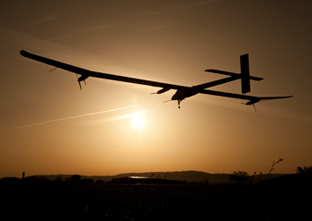 We and our partners are looking for solutions with a future, not costly technologies.
We and our partners are looking for solutions with a future, not costly technologies.
And we already have these great technological solutions, which can let us move forward and open up new markets while looking after the environment.
Bertrand Piccard: do you think we’re really looking at solar-powered airliners one day ?
No, clearly we aren’t looking to launch out into building passenger airliners.
We aren’t looking at commercial development; the scientific venture is what is driving us.
Obviously, the aviation industry is going to have to change to survive ever-rising fuel prices, but unlike Solar Impulse, aircraft engines are clearly not about to go completely fuelless!
Our ultimate aim is a round-the-world flight "without fossil fuel or pollution".

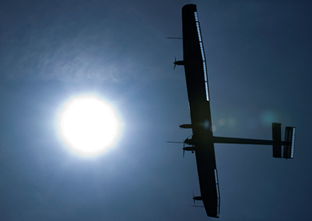 The reason I initiated this project is for Solar Impulse to carry messages, not passengers. Now that an aircraft can fly day and night without fuel, no-one can honestly carry on claiming that the same can’t be done for cars, buildings, heating, cooling or lighting systems.
The reason I initiated this project is for Solar Impulse to carry messages, not passengers. Now that an aircraft can fly day and night without fuel, no-one can honestly carry on claiming that the same can’t be done for cars, buildings, heating, cooling or lighting systems.
Aviation has always been a great driver of progress and innovation. It has transformed the 20th century and inspired dreams in generations. Today, with the challenges in our world, it has to keep doing that.
"All that is impossible remains to be achieved" - Jules Verne
Bertrand Piccard
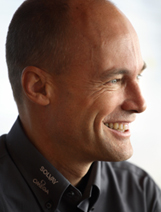 Born in Lausanne in 1958
Born in Lausanne in 1958
Medical doctor specializing in adult and child psychiatry and psychotherapy
European pioneer of hang-gliding and microlight flying: European hang-gliding aerobatics champion
Winner of the first transatlantic balloon race (1992)
Initiator and captain of the Breitling Orbiter 3, first non-stop round-the-world balloon flight
President of the Winds of Hope humanitarian foundation
Lecturer and author ("Une trace dans le Ciel" - Editions Favre 2005, "Around the World in 20 Days" – Wiley, New York 1999)
André Borschberg
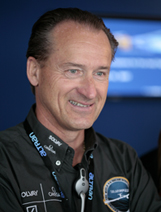 Born in Zurich in 1952
Born in Zurich in 1952
Graduate of the EPFL (Ecole Polytechnique Fédérale de Lausanne) in mechanical engineering and thermodynamics
Degree in management sciences from the Sloan School, MIT Boston
Fighter pilot with the Swiss air force
Professional aeroplane and helicopter pilot
Consultant at McKinsey and business creator
MORE INFORMATION
www.solarimpulse.com
claude.michel@solvay.com
isabelle.casse@bayer.com





